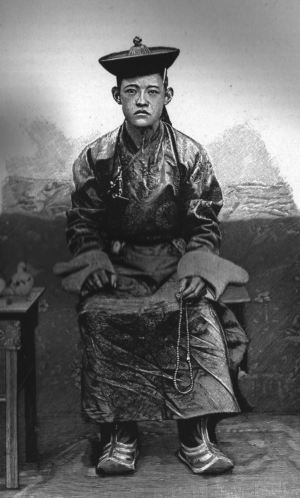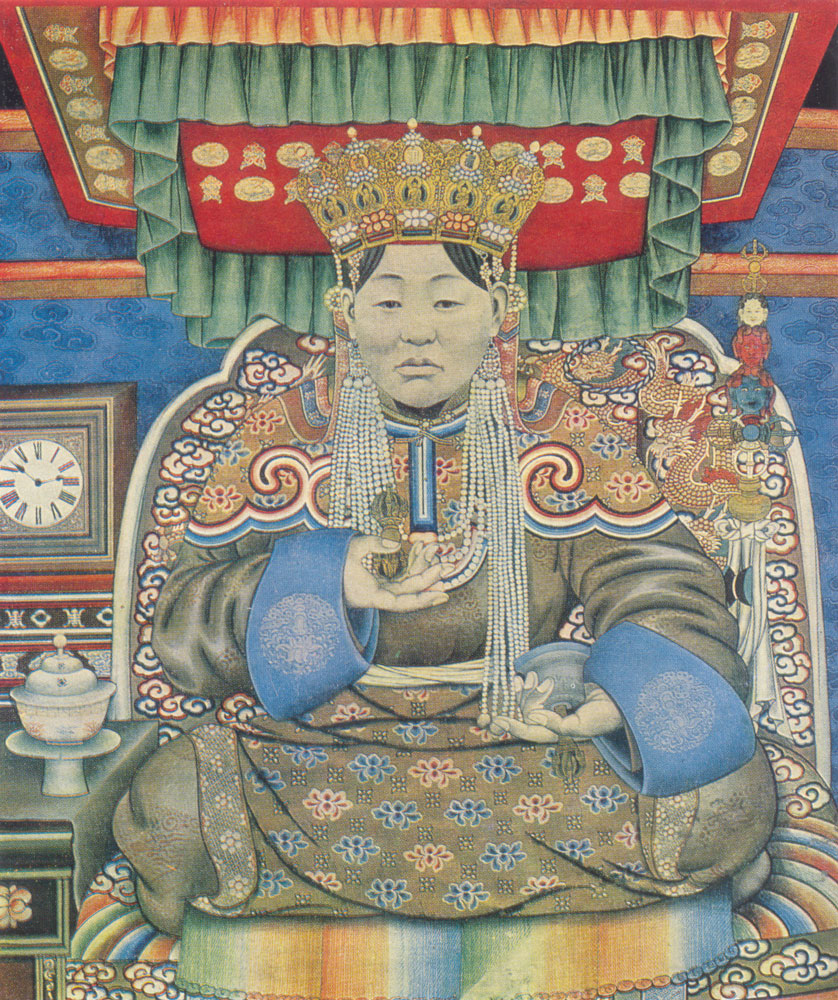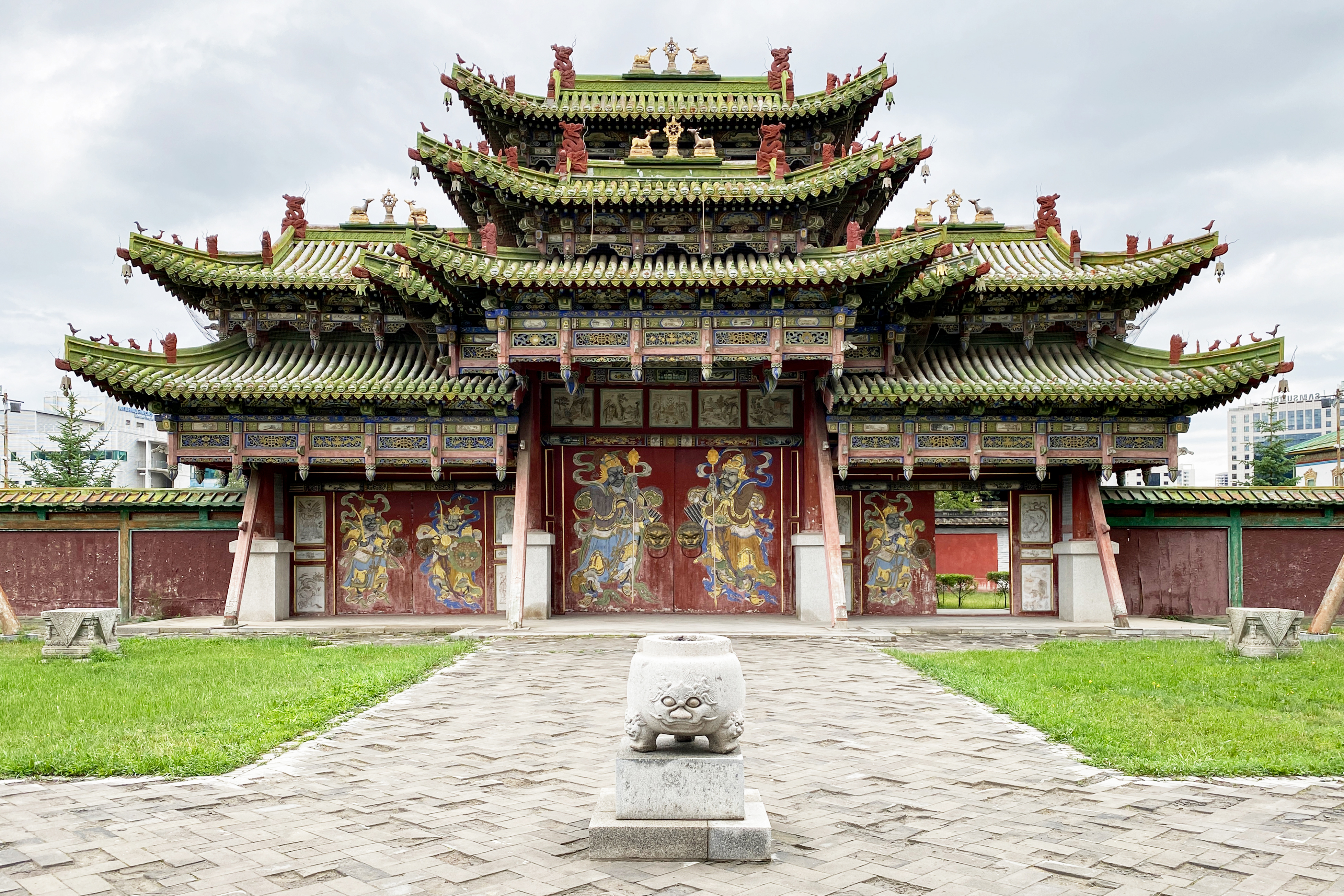1. Life
Bogd Khan's early life and religious recognition laid the groundwork for his later political leadership, establishing his spiritual authority and connection to Mongolia.
1.1. Early Life and Family
The future Bogd Khan was born on October 13, 1869, in the area of Lhasa, Tibet, specifically in Litang County, Garzê Tibetan Autonomous Prefecture, which was then part of the Qing dynasty's Sichuan Province. His birth name was Agvaan Luvsan Choijinnyam Danzan Vanchüg, also known as Gawang Lobsang Chökyi Nyima Tenzin Wangchuk. His father, Gonchigtseren, was an accountant at the court of the 12th Dalai Lama. His mother was Oidovdulam, and he had three siblings.

1.2. Religious Recognition and Move to Mongolia
At the age of four, in 1873 or 1874, the boy was officially recognized as the new incarnation of the Bogd Gegen, the 8th Jebtsundamba Khutuktu. This recognition took place in Potala Palace in the presence of the 13th Dalai Lama and the Panchen Lama. In 1874 or 1875, at the age of five, the new Bogd Gegen arrived in Urga (modern-day Ulaanbaatar), the capital of Outer Mongolia. From that point onward, he lived exclusively in Mongolia.
2. Religious Leadership
As the 8th Jebtsundamba Khutuktu, Bogd Khan held immense spiritual significance within Tibetan Buddhism. He was the third most important figure in the Tibetan Buddhist hierarchy, ranking below only the Dalai Lama and the Panchen Lama, which earned him the additional title of "Bogdo Lama." He served as the spiritual leader of Tibetan Buddhism in Outer Mongolia, wielding considerable influence as a central religious and cultural figure. His position transcended mere religious authority, providing a moral and unifying force for the Mongolian people. It was noted by contemporaries that he was not a puppet of the lamas but rather held them in his control, demonstrating a strong will and a desire to liberate Mongolia from foreign dominance.
3. Mongolia's Independence and Rule
Bogd Khan played a central role in Mongolia's struggle for independence and its subsequent governance, navigating a complex political landscape shaped by internal aspirations and external pressures.
3.1. Mongolian Independence Movement
By the early 20th century, dissatisfaction with Qing rule was widespread among Mongolian nobles and the populace. The Qing dynasty's new policies, which encouraged Chinese exploration, mining, and settlement in Outer Mongolia, and plans to abolish the existing administrative system, were seen as infringing upon Mongolian interests. This fueled a desire for self-determination.
In 1903, the 13th Dalai Lama sought refuge in Urga from the British invasion of Tibet, staying at Ganden Monastery for over a year. During this time, he met with the 8th Jebtsundamba Khutuktu multiple times, and according to Russian border officials, they discussed the establishment of an independent state from China with Mongolian Khutuktus, high lamas, and princes.
By the spring of 1911, prominent Mongolian nobles, including Prince Tögs-Ochiryn Namnansüren, persuaded the Jebtsundamba Khutuktu to convene a meeting to discuss independence. Using a religious festival as a pretext to avoid suspicion, the meeting took place on July 10, 1911. While the assembly initially faced deadlock, eighteen nobles secretly decided that Mongolia must declare its independence. They then convinced the Khutuktu to send a delegation-comprising a secular noble, an ecclesiastic, and a lay official-to Russia to seek assistance. This diverse composition aimed to convey a sense of national consensus.
3.2. Establishment of the Bogd Khanate and Enthronement
Following the Xinhai Revolution in China, which weakened the Qing dynasty, Outer Mongolia declared its independence. On December 1, 1911, the Provisional Government of Khalkha issued a general proclamation announcing the establishment of a theocracy under the Jebtsundamba Khutuktu. On December 29, 1911, the Khutuktu was formally installed as the Bogd Khan (Holy Emperor) of the new Mongolian state, marking the beginning of the Bogd Khanate. He appointed Tögs-Ochiryn Namnansüren as the first Prime Minister. In January 1913, he dispatched troops to Inner Mongolia in an attempt to unify Inner and Outer Mongolia, though these forces later withdrew at the request of the Russian Empire.
3.3. Reign and Political Challenges
Bogd Khan's reign was characterized by continuous political challenges and external interventions. After the October Revolution in 1917, the collapse of Imperial Russia, which had previously supported Mongolian autonomy, left Mongolia vulnerable. In August 1919, the Beiyang government of the Republic of China declared Mongolia an integral part of China. On November 7, Chinese forces, led by General Xu Shu under President Xu Shichang and Premier Duan Qirui, invaded Outer Mongolia. Bogd Khan was placed under house arrest in his palace. On November 17, Xu Shu imposed 64 articles of Chinese government demands, and on November 22, Xu Shichang formally revoked Mongolia's autonomy.
In 1921, the situation shifted dramatically with the intervention of Roman von Ungern-Sternberg, an anti-Bolshevik Russian general. Ungern-Sternberg's forces seized Urga, expelling the Chinese Beiyang army. During this period, Bogd Khan was briefly a puppet of Ungern, though some accounts suggest he was temporarily suspended from his position as head of state and later orchestrated a counter-coup against Ungern. However, Ungern's brutal rule alienated the populace.
In April 1921, Bogd Khan sought assistance from Beijing, but a revolution led by the Mongolian People's Party (MPP) and Buryat revolutionaries, supported by the Red Army, took control of the government. Following the Mongolian Revolution of 1921, Bogd Khan was allowed to remain on the throne as a limited monarch until his death in 1924, a year after his wife's passing. This marked a significant shift in power, as the new government, influenced by Soviet communists, began to assert control.
3.4. Relationship with the Mongolian People's Party
Following the 1921 revolution, Bogd Khan's political role was significantly curtailed. From December 16, 1921, he served as an honorary advisor to the Mongolian People's Party. On December 29, 1921, he assumed the title of Head of State of the Mongolian Autonomous Provisional Government. He resigned from his honorary position with the MPP and left the party on February 29, 1924, remaining as the head of state until his death. This arrangement reflected the post-revolutionary political alignment, where the traditional religious authority was maintained in a symbolic capacity while real power shifted to the new communist-leaning government.
4. Personal Life
Bogd Khan's personal life, particularly his marriage and family, reflects a blend of traditional monastic life and the unique circumstances of his position as a spiritual and temporal ruler.
4.1. Marriage and Family
Despite being a monk, Bogd Khan married Tsendiin Dondogdulam, who was seven years his junior, in 1902 after a seven-year courtship. She was known as Ekh Dagina (Эх ДагинаMongolian, "Dakini Mother") and was believed to be a manifestation of White Tara. The couple had one son, born in 1904. Although their son was considered for the title of Crown Prince of the Bogd Khanate in 1912, he tragically died in 1913 at the age of nine before any formal enthronement.

Tsendiin Dondogdulam passed away on April 30, 1923, after five years of illness. Following her death, a woman named Genepil from the northern regions was chosen to be his queen. However, Bogd Khan himself died less than a year later in 1924. Genepil returned to her family but was later executed in 1938 during the Stalinist repressions in Mongolia.
5. Ideology and Statements
Bogd Khan held strong views on the presence of Chinese people in Mongolia, particularly their impact on the environment. He viewed the Chinese as "destroyers of the ecosystem" due to their agricultural practices, which he believed turned the dry grasslands into deserts. In a notable statement, he issued a command reflecting his critical perspective:
"Do not associate with Chinese people! If you imitate the Chinese, you will die. Let us annihilate those Chinese who have entered various parts of Mongolia and turned the grasslands yellow by cultivating the land. Let us ride our swift horses south and strike them down."
This statement highlights his deep concern for environmental protection and ecological balance, framing it within the context of defending his homeland and expelling what he considered an existential threat to the Mongolian way of life.
6. Controversies and Criticisms
Bogd Khan was the subject of various allegations, particularly during the propaganda campaigns organized by Mongolian Communists. These campaigns accused him of personal misconduct, including being a prolific poisoner, a pedophile, and a libertine. These claims were subsequently repeated in non-scientific literature.
However, analysis of historical documents stored in Mongolian and Russian archives does not confirm these statements, suggesting they may have been part of a deliberate effort to discredit him. The Polish traveler Ferdinand Ossendowski claimed to have known Bogd Khan and recorded that the Khan knew "every thought, every movement of the Princes and Khans, the slightest conspiracy against him, and the offender is usually kindly invited to Urga, from where he does not return alive." Yet, a comparative analysis of Ossendowski's book and historical manuscripts has not confirmed his claims of acquaintance with the Bogd Gegen. These counterarguments provide important context, suggesting that some criticisms may have been politically motivated or lacked verifiable evidence.
7. Death and Posthumous
The death of Bogd Khan marked a significant turning point in Mongolian history, leading to profound changes in the country's political structure and the handling of the Jebtsundamba Khutuktu lineage.
7.1. Death
Bogd Khan died on May 20, 1924, in Ulaanbaatar, at the age of 55. The official cause of his death was reported as cancer. However, rumors circulated that he was poisoned by Khorloogiin Choibalsan, a Mongolian communist leader, allegedly at the instigation of the Soviet Red Army.
7.2. Post-Death Government Actions and Reincarnation Issue
Immediately following Bogd Khan's death, the government took control of his imperial seal, as stipulated by the November 26, 1924, Constitution of the Mongolian People's Republic. Balangiin Tserendorj served as the acting Head of State from May 20 to November 24, 1924.

The Mongolian Revolutionary government, heavily influenced by Soviet communists, declared that no further reincarnations of the Jebtsundamba Khutuktu were to be sought, effectively ending the traditional lineage's temporal power. The Mongolian People's Republic was subsequently established. Despite this, rumors about a new reincarnation of the Jebtsundamba Khutuktu appeared in Mongolia in the same year, and again in 1925. In November 1926, the 3rd Great Khural of the Mongolian People's Republic approved a special resolution prohibiting searches for reincarnations of the Bogd Gegen. A final prohibition was approved by the 7th Congress of the Mongolian People's Revolutionary Party and the 5th People's Great Khural in 1928.
Nevertheless, a subsequent reincarnation of the Bogd Gegen was found in Tibet, a boy born in Lhasa in 1932. This was not publicly announced until the collapse of the USSR and the democratic revolution in Mongolia. The 9th Jebtsundamba Khutughtu was formally enthroned by Tenzin Gyatso, the 14th Dalai Lama, in Dharamsala in 1991, and subsequently in Ulaanbaatar in 1999. He passed away in 2012.
8. Chronology
Bogd Khan's reign was associated with the "Gongdai" (共戴, Communal Reign) era, which was officially used during his rule.
| Era Year | Western Calendar | Sexagenary Cycle | Era Name |
|---|---|---|---|
| 1st | 1911 | Rénchén (壬辰) | Gongdai (共戴) |
| 2nd | 1912 | Guǐyǒu (癸酉) | Gongdai (共戴) |
| 3rd | 1913 | Jiǎxū (甲戌) | Gongdai (共戴) |
| 4th | 1914 | Yǐhài (乙亥) | Gongdai (共戴) |
| 5th | 1915 | Bǐngzǐ (丙子) | Gongdai (共戴) |
| 6th | 1916 | Dīngchǒu (丁丑) | Gongdai (共戴) |
| 7th | 1917 | Wǔyín (戊寅) | Gongdai (共戴) |
| 8th | 1918 | Jǐmǎo (己卯) | Gongdai (共戴) |
| 9th | 1919 | Gēngchén (庚辰) | Gongdai (共戴) |
9. Legacy and Residences
Bogd Khan's legacy is deeply intertwined with Mongolia's national identity and its journey through a tumultuous period of political transformation. His residences serve as tangible reminders of his historical significance.
9.1. Residences
Bogd Khan maintained several main residences in Urga (Ulaanbaatar), including the Green Palace, Yellow Palace, Brown Palace, and White Palace. Among these, the Green Palace, also known as the Winter Palace, has been preserved and is now a significant tourist attraction in Ulaanbaatar. The site of his summer palace is now occupied by the Government Palace in Ulaanbaatar. These preserved sites offer insights into the lifestyle and cultural context of the last monarch of Mongolia.

9.2. Historical Evaluation and Impact
Bogd Khan's rule and activities had a profound impact on Mongolian history and society. He is widely recognized for his pivotal role in leading the movement for Mongolian independence from the Qing dynasty, a crucial step in the nation's self-determination. His spiritual authority as the Jebtsundamba Khutuktu provided a unifying force during this period of national awakening.
His reign, however, was marked by complex political challenges, including interventions from China and Russia. His initial absolute rule transitioned into a limited monarchy after the 1921 revolution, reflecting the growing influence of communist ideology and the shift towards a more modern political system. Despite the curtailment of his temporal power, his continued presence on the throne until his death lent a degree of legitimacy and continuity during a period of radical change.
Later generations have evaluated his role from various perspectives. While some highlight his contributions to national identity and sovereignty, others critically examine the limitations of his power in the face of external pressures and the internal political dynamics that ultimately led to the establishment of the Mongolian People's Republic. His unique position as both a spiritual leader and a temporal ruler makes him a complex and enduring figure in Mongolian history.